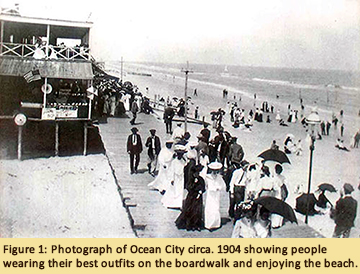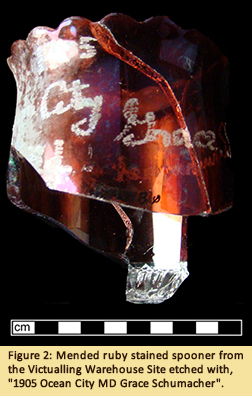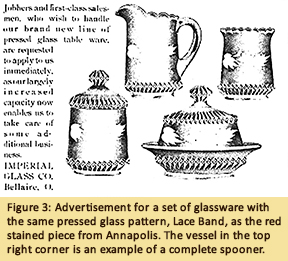September 2016
By Erin Wingfield, MAC Lab Collections Assistant
 Ocean City, Maryland began as an isolated fishing village located on a small barrier island. It only developed into a popular beach resort after the addition of the railroad and Atlantic Hotel in 1876. With greater accessibility, the city continued to grow with the iconic boardwalk constructed in 1900 and Trimpers Amusements following soon after (Ocean City Maryland n.d.). Men and women traveled on the railroad to stroll along the boardwalk in their suits and dresses (Figure 1). After enjoying the sights, amusements and a good meal, many returned with ruby stained glassware as inexpensive souvenirs of their trip, either etched with their names or those of their loved ones (Mann 2016).
Ocean City, Maryland began as an isolated fishing village located on a small barrier island. It only developed into a popular beach resort after the addition of the railroad and Atlantic Hotel in 1876. With greater accessibility, the city continued to grow with the iconic boardwalk constructed in 1900 and Trimpers Amusements following soon after (Ocean City Maryland n.d.). Men and women traveled on the railroad to stroll along the boardwalk in their suits and dresses (Figure 1). After enjoying the sights, amusements and a good meal, many returned with ruby stained glassware as inexpensive souvenirs of their trip, either etched with their names or those of their loved ones (Mann 2016).
Ruby stained glassware is sometimes mistaken for a similar, earlier glass type, ruby flashed glass. The flashing process involved taking hot blown glass and dipping it in a layer of colored glass material before shaping. This produced a thin layer of colored glass on top of the clear glass. Staining became a more economical substitute for this technique. Instead of using colored glass, staining involved brushing already finished pressed glass with a chemical solution, typically including copper sulfate for ruby glass. The glassware would then be reheated in a kiln, adhering the chemicals and changing the color. Other colors besides ruby were produced, though in much less quantity, by applying different chemicals including amber, green, and a cranberry or pink variant (McKearin & McKearin 1989:34, Miller 1988:22). This process allowed decorating companies to purchase premade pressed glass in bulk and then use unskilled labor to apply the color themselves (Mackinac State Historic Parks 2015). However, even though the resulting color did adhere to the surface of the glass, the final product was inferior to flashed glass. The colored surface scratched more often and showed signs of wear extremely easily (Miller 1988:22).
The golden age of ruby stained glassware occurred between 1892-1912, as a result of increased interest from the Chicago Columbian Exposition (Heacock 1986:4; Miller 1988:22). Ruby stained glassware became a popular substitute for more expensive bohemian glass (McKearin & McKearin 1989:34). It is estimated there were over 200- 300 different patterns of ruby stained glassware due to the process of decorating already finished glassware with different colorations (Miller 1988:22). Molds for the original pressed glassware were also retooled over time due to wear or to reduce the expense of creating new patterns without having to make an entirely new mold. Toward the later years of this period, interest began to wane and this glassware was sold as cheap souvenirs at beach towns and fairs. Some researchers believe the ruby stained glass sold as souvenirs may have been purchased from decorating companies as close-outs or seconds, allowing them to be decorated and resold even more cheaply (Heacock 1986:5-7). These souvenirs were typically personalized with the location, date and name of the person purchasing them, or of a loved one (Mackinac State Historic Parks 2015). Fancier, more expensive pieces may have been engraved with a copper wheel. This was spun by a skilled artisan on a lathe who used abrasive pastes and different sized wheels to carve away the ruby color in intricate patterns (McKearin & McKearin 1989:32; Mackinac State Historic Parks 2015; Pattern Glass School n.d.). This work was more time consuming than the other method of decoration, acid etching. Acid etching did not require a skilled artisan; instead, anyone could be quickly trained to coat the glass in a resistant material, such as beeswax or asphaltum, and scratch out a design through the coating. This was done with either a needle or an already designed steel etching plate. They would then dip the glassware in hydrofluoric acid which would only bubble the surface of the scratched area, and then peel off the resistant layer leaving the final design. In contrast to engraved pieces, acid etched decorations would not leave a concave or deep design in the glass and would instead appear flat and at
300 different patterns of ruby stained glassware due to the process of decorating already finished glassware with different colorations (Miller 1988:22). Molds for the original pressed glassware were also retooled over time due to wear or to reduce the expense of creating new patterns without having to make an entirely new mold. Toward the later years of this period, interest began to wane and this glassware was sold as cheap souvenirs at beach towns and fairs. Some researchers believe the ruby stained glass sold as souvenirs may have been purchased from decorating companies as close-outs or seconds, allowing them to be decorated and resold even more cheaply (Heacock 1986:5-7). These souvenirs were typically personalized with the location, date and name of the person purchasing them, or of a loved one (Mackinac State Historic Parks 2015). Fancier, more expensive pieces may have been engraved with a copper wheel. This was spun by a skilled artisan on a lathe who used abrasive pastes and different sized wheels to carve away the ruby color in intricate patterns (McKearin & McKearin 1989:32; Mackinac State Historic Parks 2015; Pattern Glass School n.d.). This work was more time consuming than the other method of decoration, acid etching. Acid etching did not require a skilled artisan; instead, anyone could be quickly trained to coat the glass in a resistant material, such as beeswax or asphaltum, and scratch out a design through the coating. This was done with either a needle or an already designed steel etching plate. They would then dip the glassware in hydrofluoric acid which would only bubble the surface of the scratched area, and then peel off the resistant layer leaving the final design. In contrast to engraved pieces, acid etched decorations would not leave a concave or deep design in the glass and would instead appear flat and at  times blurry (McKearin & McKearin 1989:33; Pattern Glass School n.d.).
times blurry (McKearin & McKearin 1989:33; Pattern Glass School n.d.).
The particular piece of ruby stained glassware shown above was found at the Victualling Warehouse site, 18AP14 in Annapolis, Maryland (Figure 2). This site had been used for various stores and residences since the 1740’s (Pearson 1991:i). The ruby staining on this piece is heavily worn and faded. It is most likely a spooner, a vessel designed to hold spoons and used with other tea wares such as creamers and sugar bowls. However, most personalized souvenir glassware was purchased individually as a memento instead of in sets (Tascione 2016). This particular pattern is recognized as Lace Band (Figure 3), and was produced by the Imperial Glass Co. of Bellaire, Ohio from 1902 through 1910 (Heacock 1986:138, 149). The blurry acid etched decoration reads, “1905 Ocean City MD Grace Schumacher”. Unfortunately, we were unable to find any information about Grace and her life in Annapolis. Perhaps she was a resident, or a shop worker, or maybe she had no connection to Annapolis, and her spooner was discarded or resold by someone else.
| References |
|
| Mann, Bunk |
| 2016 |
21 Jul. 2016. How the Boardwalk was in the Early - 1900’s. http://www.mdcoastdispatch.com/2016/07/21/vanishing-ocean-city-with-bunk-mann-july-22-2016/, accessed 26 Aug. 2016. |
|
| Heacock, William |
| 1986 |
Encyclopedia of Victorian Colored Pattern Glass vol. 7: Ruby-Stained Glass from A to Z. Antique Publications, Inc., Marietta, OH. |
|
| Mackinac State Historic Parks |
| 2015 |
25 Sept. 2015. Frank Kriesche’s Ruby Souvenir Glasses. http://www.mackinacparks.com/frank-kriesches-ruby-souvenir-glasses/, accessed 26 Aug. 2016. |
|
| McKearin, Helen & George S. McKearin |
| 1989 |
American Glass Book. Bonanza Books, New York, NY. |
|
| Miller, Donald |
| 1988 |
Tri-state Once a Prime Member of Ruby Stained Glass. Pittsburg Post Gazette 15 Jan. 1988:22. |
|
| Ocean City Maryland |
| n.d. |
OC History. http://ococean.com/explore-oc/oc-history/, accessed 26 Aug. 2016. |
|
| Pattern Glass School |
| n.d. |
Is it Etched? Sandblasted? Is it Engraved? or Cut?. http://www.patternglass.com/School/Lessons/ColorlessDecor.htm, accessed 26 Aug. 2016. |
|
| Pearson, Marlys J |
| 1991 |
Archaeological Excavations at 18AP14: The Victualling Warehouse Site, 77 Main Street, Annapolis, Maryland 1982-1984. Archaeology in Annapolis, College Park, MD. |
|
| Tascione, Janice |
| 2016 |
Personal Communication. 27 Aug. 2016. |
|